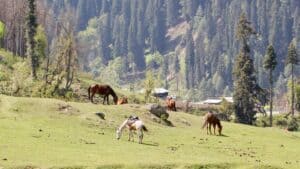Kashmir – One Year After Abrogation of Article 370
“What’s in a name?” I, like many Kashmiris, spent the last 12 months contemplating the various shades of this Shakespearean thought. Kashmir has seen four wars and more than three decades of insurgency and civil strife, at the core of which is this very question – the question of identity.
Who understands, better than us, the cost that populations paid for focusing narrowly on trying to define their idea of collective identity superseding the complex quagmire of identities that each individual or a sub-group is! After all, identity is a part of one’s being not the end or wholeness of it. There are questions bigger than, more immediate and more relevant than the question of identity – the issues of aspirations, material achievements, livelihood, economic and social development; education, healthcare, justice, connectivity opportunities and accessibility. The last one year has seen a sudden shift in focus on these facets of our lives stunning us out of our atrophy.

On August 5, 2019, Central Government in India amended Article 370 of the Constitution of India; removed Article 35A; divided the state of J&K into two parts; and changed the status of J&K to that of a centrally administered Union Territory. Article 370 was the constitutional window through which the Constitution of India was applied to J&K – Article by Article. Conveniently (to those in power) many articles failed to pass through this window.
Critics of the move allege that the constitutional amendment of 370 is a majoritarian move by the Hindu majority of India. But if you look at it closely, it was in J&K that majoritarian thrust was being enforced using Article 370 as a screen. Provisions relating to local minorities, tribal rights, rights of Dalits (Valmiki’s) including positive discrimination for government jobs did not apply to J&K. Hindu and Sikh refugees from West Pakistan were not granted citizenship while the demand of reservation for deprived communities like Paharis (mountain people) and other economically weaker sections went unaddressed. The underbelly of the Muslim majority state suffered double repression wherein their rights and aspirations became oblations to the fire of sub-national and religious identity.

Article 35A was a provision introduced by the erstwhile Maharaja of J&K (long before the accession of J&K to India) to preserve the repressive (feudal/patriarchal values of the time. Article 370 itself is gender neutral, but the way permanent residents were defined in the state constitution based on the notifications issued in April 1927 and June 1932 during the Maharaja’s rule were biased against women. The 1927 notification included an explanatory note which said “The wife or a widow of the state subject shall acquire the status of her husband as state subject of the same class as her husband, so long as he resides in the state and does not leave the state for permanent residence outside the state.” This was widely interpreted as also suggesting that a woman from Jammu and Kashmir who marries outside the state would lose her status as a state subject and hence her rights to ownership and inheritance of property.
It was a strange time one year ago. The credibility of mainstream political parties in J&K was at all time low in the valley due to their abjectly ineffective governance and dynastic succession while separatist leaders were seen as self-serving puppets of Pakistan (a fact borne out by the declining response to their strike calls) leading to a situation of political vacuum – a state of being adrift and rudderless.
The insurgents who died did get gatherings at their funerals, but it was more of an expression of the stoic resignation of the people; and these funerals were happening depressingly often – a marker of the futility of this path. Bringing the state under Central rule has, for the time being at least, put an end to the chaos and given a sense of direction to J&K – an alternative path, a new set of goals and novelty in public discourse. Whether it is its zeal to convince the population about the honesty of its intentions or an overdrive to correct what it saw as wrongs of the past, the government and local administration launched an outreach drive conducting hundreds of public meetings and sending senior officers camping in villages. Village and Town level local governance bodies known as Panchayati Raj Institutions were activated by conducting local & urban body elections (with good participation).

It was for the first-time that Panchayati Raj institutions were empowered to carry out their mandated development work as per 73rd Constitutional Amendment which devolved substantial powers to local bodies all over India but not in J&K due to Article 370/35A. One of the factors responsible for the economic lagging of J&K (other than violence, radicalism and insurgency) despite its enormous potential, was the fact that Article 370 made investment from other states in India into J&K difficult. After the amendment, a Global Investment Summit was organised in which 168 MOU’s worth Rs. 136 billion (USD 1.8 billion) were signed. If this materialises, it could change the world view of the local youth, who are caught in the unending spiral of funerals, propaganda, extremism, stone pelting, unemployment, recruitment and funerals.
The abrogation of 370 has seen sweeping reforms and improvement in all sectors of J&K. These include the opening of 50 new degree colleges and seven new medical colleges, the implementation of power sector reforms with the setting up of power corporations and new power projects; the awarding of geographic indicator status to Kashmiri saffron, strengthening of road and rail connectivity through commencement of work of major highway projects, finalisation of light rail transit system, conduct of first Khelo India winter sports in the resort town of Gulmarg with country wide participation. All this can all be accredited to the Central Government’s drive to present the people of J&K with an alternative to their existing situation.

Economic growth cannot happen in a closed environment in today’s world. Hence open minds and open market will ensure that the youth of the region are put in on a path of greater progress. The constitutional integration of J&K with India also gives a boost to investment, innovation, income and employment. However, opportunities thrown up by the abrogation are also being misused by the local elite political class to facilitate corruption and to incite sentiments to generate soft separatism and political violence so as to create a constituency on which they can piggy bag to milk the Government of India and its agencies.
Government Policy must be reviewed regularly by continuing and further developing its comprehensive program of public outreach. The administration must remain on its toes to ensure that the radical fundamentalists, terrorist tanzeems and their backers across the Line of Control don’t take advantage of the situation while simultaneously engaging with political actors, civil society and other stakeholders in J&K.
The people of J&K need this hiatus to last for some time at least so that they can have a calm look at the new order before them – an order that prioritises needs and issues closer to them. After all “What’s in a name?”
Nadir Ali Wani is a resident of Hawal in Downtown Srinagar the capital of Jammu and Kashmir. He holds a Masters degree in Conflict Studies and International Relations from Jawahar Lal Nehru University New Delhi. Mr Ali has an abiding interest in the study of conflicts in South Asia with particular interest in the dynamics of conflict and process towards its resolution in Kashmir. He worked as a Research Assistant to Professor Amitabh Mattoo at JNU, New Delhi while conducting dialogue with various members of civil society and with the Kashmiri leadership. He has been associated with the Interlocutor’s Group after the 2010 uprising in Kashmir in the capacity of a Research Officer. Currently Mr Ali is Director, Center for Peace and Justice a research based group in Srinagar, which is a non-profit organisation working with youth affected by violence, including those injured by pellet firing by security forces, stone pelters; and those who have taken to drugs in the troubled region. He has no political affiliation. The views expressed here are entirely his own.











